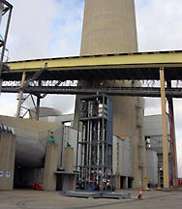Coal-generated CO2 captured in Australia -- a first

In a first for Australia, carbon dioxide (CO2) has been captured from power station flue gases in a post-combustion-capture (PCC) pilot plant at Loy Yang Power Station in Victoria’s Latrobe Valley.
CSIRO Energy Technology Chief, Dr David Brockway, said the milestone followed the Garnaut Report’s recognition that Australia has an important role to play in developing low emission coal technologies such as PCC.
“PCC uses a liquid to capture CO2 from power station flue gases and can potentially reduce CO2 emissions from existing and future coal-fired power stations by more than 85 per cent,” he said.
“Coal is the primary fuel for over 80 percent of Australia’s current power supply – it’s what turns the lights on in most homes – so we need to find ways to make it a cleaner energy source. This is the first time anyone in the Southern Hemisphere has captured CO2 using the PCC process at a power station and we are thrilled we’ve been able to prove this technology,” Dr Brockway said.
The 10.5 metre-high pilot plant is designed to capture up to 1000 tonnes of CO2 per annum from the power station’s exhaust-gas flues. Future trials will involve the use of a range of different CO2-capture liquids.
CSIRO is undertaking similar PCC research at Munmorah near NSW and Beijing, China, and is negotiating the installation of another pilot plant at a Queensland site.
“Climate change is a key issue for Australia and we’re delighted to be part of finding a solution to this global challenge,” Loy Yang Power Chief Executive Ian Nethercote said.
“We’re pleased to be working with CSIRO to identify ways to significantly reduce greenhouse gas emissions from the energy sector,” Mr Nethercote said.
The project is part of the Latrobe Valley Post Combustion Capture Project – a joint collaboration between Loy Yang Power, International Power Hazelwood, government and researchers from CSIRO’s Energy Transformed Flagship and the CO2CRC (including Monash and Melbourne Universities). The Loy Yang component of the project is supported by the Victorian Government for A$2.5million through the Energy Technology Innovation Strategy.
Source: CSIRO





















